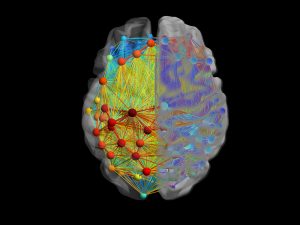
Illustration of the neurological connections in the brain (in this case, controlling speech production).
Credit: Stefan Fuertinger and Kristina Simonyan, Icahn School of Medicine at Mount Sinai
NIH support from: National Institute on Deafness and other Communication Disorders
Artificial intelligence (AI). Machine learning. To most people, these are just buzzwords and synonymous. Whether or not we fully understand what both are, they are slowly integrating into our everyday lives. Virtual assistants such as Siri? AI is at work. The personalized ads you see when you are browsing on the web or movie recommendations provided on Netflix? Thank AI for that too.
AI is defined as machines having intelligence that imitates human behaviour such as learning, planning and problem solving. A process used to achieve AI is called machine learning, where a computer uses lots of data to “train” or “teach” itself, without human intervention, to accomplish a pre-determined task. Essentially, the computer keeps on modifying its algorithm based on the information provided to get to the desired goal.
Another term you may have heard of is deep learning. Deep learning is a particular type of machine learning where algorithms are set up like the structure and function of human brains. It is similar to a network of brain cells interconnecting with each other.
Toronto has seen its fair share of media-worthy AI activity. The Government of Canada, Government of Ontario, industry and multiple universities came together in March 2018 to launch the Vector Institute, with the goal of using AI to promote economic growth and improve the lives of Canadians. In May, Samsung opened its AI Centre in the MaRS Discovery District, joining a network of Samsung centres located in California, United Kingdom and Russia.
There has been a boom in AI companies over the past few years, which span a variety of industries. This year’s ranking of the top 100 most promising private AI companies covers 25 fields with cybersecurity, enterprise and robotics being the hot focus areas.
AI has been causing a stir in the life sciences as well, so what are the possibilities that lie ahead?
Technology to analyze the DNA makeup (genome) of an individual is becoming cheaper over time. Add AI to our current abilities and researchers can identify unique drug targets based on patient data. A company that has made headlines recently is Verge Genomics, led by 29-year-old Alice Zhang. Verge Genomics is partnering with universities and government organizations to build a database of DNA from deceased ALS and Parkinson’s patients and applying machine learning to identify good drug targets (Endpoints News). Their Series A funding round raised USD$32 million.
Analysis of patient data with the help of machine learning could link genetic differences to disease, leading to better diagnoses. Observing the physical features of diseased cells, in combination with examining the DNA, could isolate new biomarkers for diagnosis or prognosis. This could also be applied to finding biomarkers floating in our blood or other non-invasive samples. With AI, researchers may now be able to understand the complex diseases we currently do not have the capacity to dissect.
AI will also have applications in regenerative medicine. Machine learning can be applied to research that grows stem cells or to define ideal protocols that take stem cells and differentiate them into specific cell types required by the patient (ex. liver, cells, blood cells, etc.). In addition, AI can assist scientists in standardizing and optimizing protocols to improve product quality and manufacturing processes. In time, this will result in personalized treatments.
At RIKEN Center for Developmental Biology in Japan, researchers are interested in using AI and robots to compile researchers’ knowledge and expertise to replicate their ability “to prepare high-quality cells just like the researchers can,” according to the Government of Japan.
AI could also be used to improve clinical trials for patients by “increasing trial efficiency through better protocol design, patient enrolment and retention, and study start-up,” say the results of a November 2017 ICON-Pharma Intelligence survey. This would result in reduced operational costs and better patient outcomes. AI could be applied to other health care areas such as infection control and diagnoses based on radiology.
The potential for AI in health care innovation is exciting and opens the door to many possibilities. While our knowledge of AI is expanding every day, science fiction movies and novels have given us a fantasized idea of what the future could hold.
Given the complexity of human biology, we do not have to worry about machines replacing our doctors anytime soon. Currently, scientists and doctors are still needed to define specific research goals that could benefit from AI implementation and assess whether the answers provided by the machines are viable based on our current health care standards and our understanding of human biology. There is still a need to conduct further testing in appropriate models and address regulatory requirements set up by governing bodies.
More importantly, empathy and support from a fellow human being could never be fully replaced by a machine (could it?), but maybe this will change in the future. We will just have to wait and see.
Carmen Wong
Latest posts by Carmen Wong (see all)
- The future of AI in the life sciences - August 23, 2018






Comments